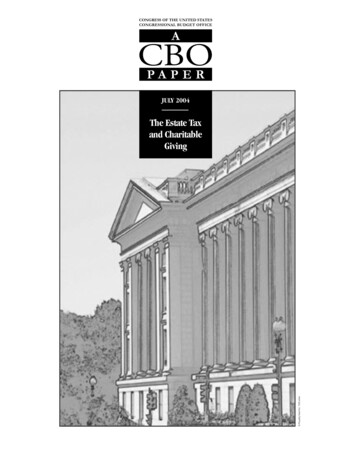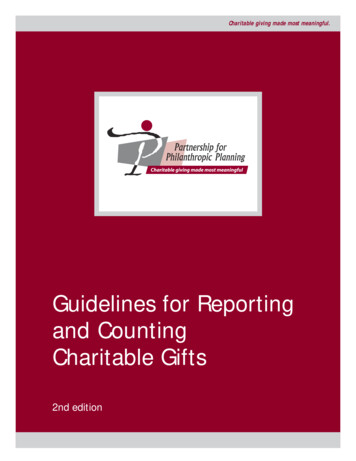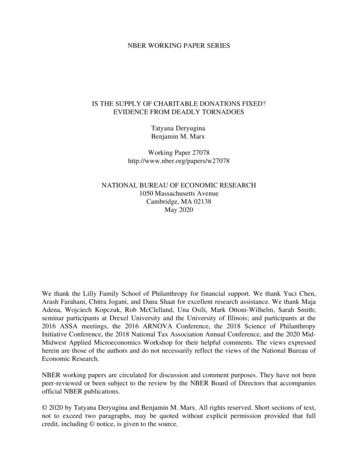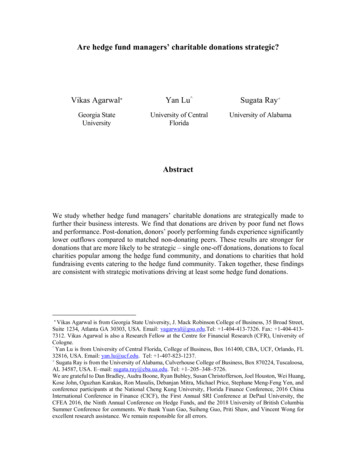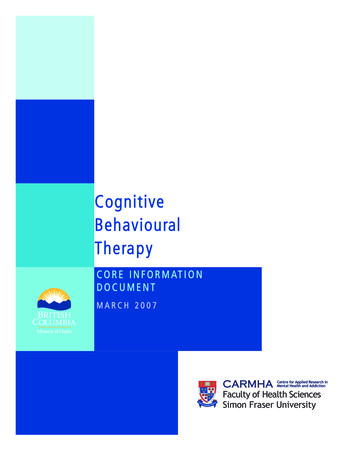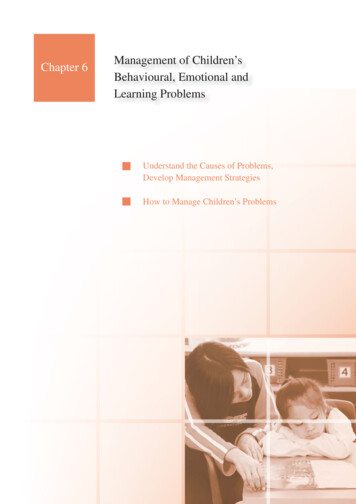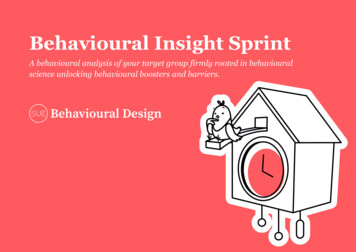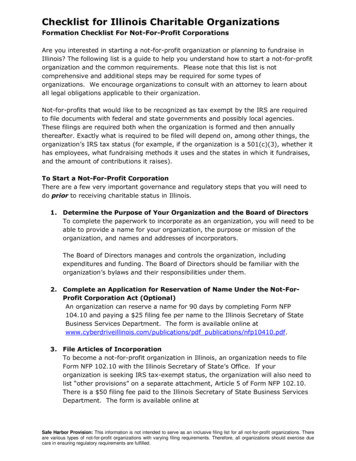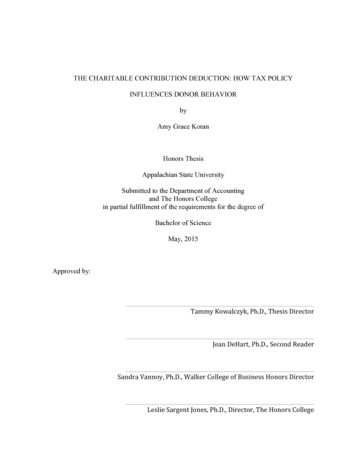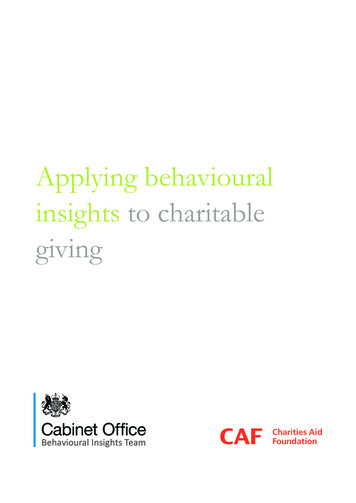
Transcription
Applying behaviouralinsights to charitablegivingBehavioural Insights Team
AcknowledgementsThe trials in this paper have been devised, led and delivered byMichael Sanders, a member of the Behavioural Insights Team (BIT),and a former BIT Research Fellow from the University of Bristol.We would like to thank those organisations who have partneredwith us in the production of this report. In particular, we would liketo thank the Charities Aid Foundation, which has supported theresearch on the application of behavioural science to payrollgiving. We would also like to thank Rob Cope (Remember aCharity), Hannah Terry, Rhodri Davies and Richard Harrison(Charities Aid Foundation), Harriet Stephens (HMRC), CeriWootton (Home Retail Group), Jason Doherty (Charities Trust),Amy Parker and Sabira Rouf (Deutsche Bank), and Steve Grimmett(Zurich). We are also grateful to Rachael Hogg and Alex Tupper forexcellent research assistance.
ContentsForeword4Executive Summary5Part I: Four Behavioural Insights8Part II: Five Behavioural Trials14References24
4 Applying behavioural insights to charitable givingForewordThe UK is a generous country, home tosome of the world’s greatestphilanthropists, to some 150,000charities, and to a public that donated 11.7billion1 to charitable causes in2011.This paper celebrates the generosity ofthe UK public, and explores new andinnovative ways of increasing charitablegiving further.It also recognises the important indirectbenefits of charitable giving that recentbehavioural research has begun toexplore.This research shows that giving bothtime and money has large benefits forthe wellbeing of the giver as well as thereceiver.Experiments have shown, for example,that individuals are happier when giventhe opportunity to spend money onothers than themselves.2beneficiaries, and for society at large.In celebrating charitable giving, thispaper takes a very practical approachthat is grounded in the rigorousanalytical methods used by theBehavioural Insights Team.This involves both understanding whatthe behavioural science literaturesuggests ‘works’ in relation toincreasing charitable giving, and thentesting and trialling these insights inpractice through the use of randomisedcontrolled trials.4The results from these trials show howsmall changes can help charities andgivers to support good causes.Michael Sanders, David Halpern &Owain ServiceThe Behavioural Insights TeamSimilarly, volunteering is associatedwith increased life satisfaction – notonly among volunteers, but in thecommunity around them.3 CharitableGiving is good for donors, for Crown copyright - not to be reproduced without prior permission from the Behavioural Insights Team
5Executive SummaryThe first part of this paper describesfour behavioural insights found in theacademic literature on giving andaltruism and shows how they might beused to support charitable giving. Thesecond part sets out the results fromfive randomised controlled trialsconducted by the Behavioural InsightsTeam that show how effective theapplication of these insights can be inpractice.Part I: Four BehaviouralInsightsInsight 1 is to ‘make it easy’. One of thebest ways of encouraging people to giveis to make it easy for people to do so.Making it easy can include:Giving people the option to increasetheir future payments to preventdonations being eroded by inflationSetting defaults that automaticallyenrol new senior staff into givingschemes (with a clear option todecline)Using prompted choice to encouragepeople to become charitable donorsInsight 2 is to ‘attract attention’. Makingcharitable giving more attractive to anindividual can be a powerful way ofincreasing donations. This can include:Attracting individual’s attention, forexample by using personalisedmessagesRewarding the behaviour you seek toencourage, for example throughmatched funding schemesEncouraging reciprocity with smallgiftsInsight 3 is to ‘focus on the social’. Weare all influenced by the actions ofthose around us, which means we aremore likely to give to charity if we see itas the social ‘norm’. Focusing on thesocial involves thinking about:Using prominent individuals to sendout strong social signalsDrawing on peer effects, by makingacts of giving more visible to otherswithin one’s social groupEstablishing group norms aroundwhich subsequent donors ‘anchor’their own gifts Crown copyright - not to be reproduced without prior permission from the Behavioural Insights Team
6 Applying behavioural insights to charitable givingInsight 4 is that ‘timing matters’. If youget your timing right, it can really helpto increase charitable donations. Thismight include:Ensuring that charitable appeals aremade at the moments when they arelikely to be most effective - forexample people are more likely tomake a donation in December thanJanuaryUnderstanding that people may bemore willing to commit to future(increases in) donations thanequivalent sums todayPart II: Five Behavioural Trialsincrease their future donations is ahighly effective way of increasing theoverall value of support for a charity, bypotentially more than 1000 over thecourse of the donor’s lifetime.Trial 2 was conducted with CharitiesTrust and the Home Retail Group. Ittested the impact of automaticallyenrolling individuals on to a schemewhich increases donations by 3% a year(with the option to opt out). Followingthis small change, the proportion ofnew donors signing up for automaticincreases rose to 49%. If institutedacross all payroll giving and direct debitschemes, this could raise an additional 40million for charities per year.This section of the paper describes thework the Behavioural Insights Team hasundertaken with a wide range of largeorganisations and charities in the UK totest these insights in practice throughfive randomised controlled trials. Thesetest the new interventions against thepractices that were used before,demonstrating the impact of theintervention.Trial 3 was conducted with HMRC andtested whether peer effects mightincrease the tendency of individuals tojoin the organisation’s Payroll Givingscheme. Employees were sentmessages from colleagues of theirs whowere already giving, and some of themreceived messages with pictures of theexisting donors. The pictures wereespecially effective, doubling the ratesof enrolment.Trial 1 was conducted with the ZurichCommunity Trust. It tested the impactof encouraging people to sign up toannual increases in their giving ratherthan just one-off increases, so thatinflation does not erode the value of anindividual’s contribution over time. Itshowed that encouraging people toTrial 4 was conducted with DeutscheBank. It looked at whether behaviouralinsights could help increase the numberof employees willing to give a day oftheir salary to charity. It showed thatpersonalised emails from the CEO weremuch more effective than generic Crown copyright - not to be reproduced without prior permission from the Behavioural Insights Team
7emails at increasing donations. Whencombined with small gifts they morethan tripled charitable donation rates,helping to raise 500,000 in one day.Trial 5 was conducted with the Cooperative Legal Services and Remembera Charity to see whether charitablegiving could be supported throughpeople’s wills. It showed that promptingpeople to give to charity was aneffective way of doubling the number oflegacy donors. Using social normmessages trebled uptake rates, and alsoled to larger donations. Crown copyright - not to be reproduced without prior permission from the Behavioural Insights Team
8 Applying behavioural insights to charitable givingPart I: Four BehaviouralInsightsPart I of this paper describes thebehavioural effects found in theacademic literature on giving andaltruism. These insights suggest thatrelatively small variations in the way inwhich people are asked to donate, or toincrease their regular donations, canmake large differences to the amountsof money donated to charity.Insight 1: Make it easyOne of the best ways to encouragepeople to give is to make donatingeasy for them. Making it easy caninclude:- Giving people the option to increasetheir future payments to preventdonations being eroded by inflation- Setting defaults that automaticallyenrol new senior staff into givingschemes (with a clear option todecline)- Using prompted choice to encouragepeople to become charitable donorsOne of the most important lessons fromthe behavioural science literature isthat if you want to encourage someoneto do something, you should make it aseasy as possible for them to do so.One of the drawbacks of Payroll Givingschemes is that the value of a monthlycontribution is often fixed in absoluteterms. With the average payroll giverstaying in the scheme for 7 years,inflation can have a considerable impacton donation levels. For example, a 10donation begun in 2005 would beworth just 7.50 today.One solution to this problem is to allownew donors to sign up to increase theirdonations automatically every year by acertain percentage, while retainingclear prompted choice for entry. This isa good example of how to ‘make iteasy’ for individuals by reducing theneed for future action. Trial 1 in Part IIof this paper shows that automaticescalation is at least as popular asstandard escalation among donors, andcan work well at helping donations keeppace with inflation.Perhaps the most effective way ofmaking something easy is by removingthe need for an individual to act at all, Crown copyright - not to be reproduced without prior permission from the Behavioural Insights Team
9by automating the process. Some UScompanies, for example, automaticallyenrol senior members of staff onto theirpayroll giving schemes, giving peoplethe choice to ‘opt out’ rather than ‘optin’. Switching the default to an ‘opt out’system, with a clear option to decline, isan effective way of enhancingdonations, as demonstrated by theresults of Trial 2 in Part II of this paper.This shows the power of defaults forsmall increases in donations.Where it is not possible or appropriateto automatically enrol individuals into agiving scheme, an alternative option isto use ‘prompted choice’. In thisscenario individuals are explicitly askedif they want to join a scheme, in whichthey will then stay until they decide towithdraw. This is how Payroll Givingschemes in the UK work. Trial 5 showsthat simply prompting people at theright time can be very effective atencouraging people to leave money tocharities in their wills.Insight 2: Attract attentionMaking charitable giving moreattractive to an individual can be apowerful way of increasing donations.This can include:- Attracting an individual’s attention,for example by using personalisedmessages- Rewarding the behaviour you seek toencourage, for example throughmatched funding schemes- Encouraging reciprocity with smallgiftsAttracting attention is about engagingsomeone’s interest and encouraging theactivity that you are seeking tomotivate through rewards of one kindor another.One starting point is to usepersonalised appeals to encourageengagement with a campaign. Researchconsistently shows that personalisedappeals are more effective than moregeneric messages.5 Trial 4 in Part II ofthis paper demonstrates this effect.Similarly, communicating the impact ofa good cause on individualbeneficiaries, rather than in totalimpact terms, can be highly effective.For example, George Loewenstein andcolleagues6,7 find firstly thatcommunicating the work of a charity in Crown copyright - not to be reproduced without prior permission from the Behavioural Insights Team
10 Applying behavioural insights to charitable givingterms of the total number of affectedindividuals was around a third less( 2.34 vs 1.45) effective at elicitingdonations as communicating that samework in terms of the struggle of anindividual child. Trial 4 in this papershows how pictures of identifiableexisting donors making appeals to theircolleagues can have similar effects.effective at raising funds than matchingup to the amount of an individual’sdonation.9 Some other studies find thatmatches at least partially crowd outindividuals’ donations,10 suggesting thatdonors care about how much moneygoes to the charity in total, and notentirely about their own contribution,although the evidence is mixed.One way to make giving more attractiveis to offer a salient, non-financialincentive. For example, Cotterill, Johnand Richardson8 find that offering topublicise the names of everyone whodonates a book to the local libraryincreases donations compared with notoffering that incentive. The ZurichCommunity Trust also offer a lottery towin a small prize for everyone whomakes a donation, which adds both anincentive and a fun element to theirapproach.Alternatives to standard matchingmight make donations to charitythrough an employer more attractive,and could overcome the problem ofcrowding out. Examples include: nonlinear matching, where matchesincrease the more a person chooses todonate, or the more people in the firmare donating; or lottery matches, whereone person’s chosen charity is selectedto receive the entire match pot for agiven month.11An effective way of rewarding giving onan ongoing basis is for employers tooffer some kind of matched donations –for example donating 1 for every 2donated by employees. Matches can bea good way of increasing the value ofmoney going to a charity. However, itshould also be acknowledged thatmatched-funding is not always the mostefficient way for an organisation tomaximise donations. One study, forexample, found that simply announcinga large initial donation was moreResearch has consistently shown thatpeople exhibit a strong gift exchangemotive – that when someone givessomething to an individual, they feel adesire to give something back. In thecase of charitable giving, this meansthat small gifts to donors can encouragemore people to donate, particularly ifthe gift is seen as a ‘thank you’ ratherthan as something of a particular valuethat needs to be reciprocated to thesame level. Trial 4, in Part II, shows justhow powerful this can be – particularlywhen combined with personalisedappeals to individuals. Crown copyright - not to be reproduced without prior permission from the Behavioural Insights Team
11Insight 3: Focus on the socialWe are all influenced by the actions ofthose around us, which means we aremore likely to give to charity if we seeit as the social ‘norm’. Focusing on thesocial involves thinking about:- Using prominent individuals to sendout strong social signals- Drawing on peer effects, by makingacts of giving more visible to otherswithin one’s social group- Establishing group norms aroundwhich subsequent donors ‘anchor’their own giftsPeople are strongly influenced by theactions of those around them. We dowhat we see other people doing, andwe are influenced by the decisions thatother people take. The behaviouralscience literature is full of examplesthat demonstrate how these ‘socialnorms’ influence individuals’ behaviour.The specific research around charitablegiving suggests that there are manydifferent ways in which social influencecan be brought to bear.The impact an individual can have bysending strong signals to a particulargroup or community is one form ofinfluence. For example, experimentsconducted by Wikipedia showed that amessage from the site’s founder, JimmyWales, was more likely to encourage adonation than similar messages notattributed to Wales.12 Similarly, bigphilanthropists, such as Brooke Astor,Bill Gates or Warren Buffett, can sendpowerful signals about which causesare most worthy and encourage othersto donate to charities they support. Thismay be because people aspire to bemore like these prominent figures,13 orbecause they believe that they makegood decisions about charities.14Another form of social influence, whichis of particular interest for thosewishing to establish more habitualisedgiving practices within organisations, ispeer effects. Individuals are more likelyto donate to charity if they see othersaround them doing so. The more similarthese people feel they are, the strongerthe peer effect. Research has shown,for example, that people assigned toworkplace fundraising campaign teamswith more people who already give aresignificantly more likely to givethemselves.15 When asked to donate totheir university’s alumni fund by aformer college roommate, alumni aremore likely to do so than if asked by astranger.16 Similar effects were found inTrial 5, in Part II of this paper. This trialexamines the effect of a simple socialnorm message on take-up of legacygiving (in this case, telling people thatmany people who write wills leavemoney to charity). Crown copyright - not to be reproduced without prior permission from the Behavioural Insights Team
12 Applying behavioural insights to charitable givingKnowing the amount that other peopledonate can also be effective. Forexample, one study found that whendonation amounts are revealed todonors, they quickly conform to thegroup norm.17 A single, visible donationof around 60 or more on websites thathelp people raise money for charity willencourage others to give more thanthey might have done in the absence ofsuch an anchor.18Other research has supported thisfinding. However, it is important torecognise that the level at which the‘anchor’ is set is critical to achieving apositive impact. This was demonstratedin a study in which visitors to a CostaRican national park were asked to makedonations. It found that when peoplewere told about previous, highdonations ( 10), they increased theirdonations, but that when theinformation was about a low donation( 2), their donation decreasedsignificantly.19Insight 4:Timing mattersIf you get your timing right, it canreally help to increase charitabledonations, for example by:- Ensuring that charitable appeals aremade at the moments when they arelikely to be most effective;- Understanding that people may bemore willing to commit to future(increases in) donations thanequivalent sums todayOne particularly interesting insight fromthe behavioural science literaturerelates to the impact that time hasupon people’s decision making. It isuseful to think about timing both fromthe perspective of when to asksomeone to give money to charity andwhether it is possible and desirable todefer costs or bring forward a benefit toencourage stronger engagement.Many studies have shown theimportance of recognising moments ofopportunity to support behaviouralchange. This might include, forexample, when someone changes job,or moves house. This is the momentwhen an individual is already makingimportant procedural changes, forexample providing bank account detailsand signing new contracts. Targetingthese moments when setting up newPayroll Giving schemes is likely to be Crown copyright - not to be reproduced without prior permission from the Behavioural Insights Team
13more effective than asking someone tojoin a programme in the middle of theiremployment contract.There will be similar moments ofopportunity in relation to any charitablegiving campaign. Trial 5, for example,which seeks to increase the numbers ofthose giving money in their wills, linksthe appeal to the point at which anindividual is writing their will.People value the future less than theyvalue the present, and so may takedecisions which favour their presentselves over their future selves. Whilethis can sometimes be in their bestinterest, often it is not.For example, hyperbolic discounting isan extreme form of this ‘discounting’the future, where the next period(tomorrow, next year), is discountedvery heavily. This leads toprocrastination, where we put off smallactivities until tomorrow which costlittle effort now but whose benefits inthe long run are large. We see thismost commonly in behaviours such aspeople’s failure to save for retirement,quit smoking or avoid tempting butunhealthy foods.changes in their circumstances andinflation eroding their donation’s value.Making a decision to increase theamount you donate every monththrough payroll giving or direct debitmay be difficult or time consuming, andunless prompted, people may forget todo it. One option to help people wouldbe to allow donors to pre-commit toincreases in their donations when theysign up to give. Trials 1 and 2 in Part IIlook at ways in which this can be putinto practice.People may also wish to increase theirdonations, but may struggle to do soimmediately. Breman20 finds that askingpeople to increase their donations inthree months’ time leads to more andlarger increases than when people areasked to increase immediately.People may be less loss averse withtheir future income than with moneythey already have, and this may beespecially the case for ‘windfall’earnings, such as bonuses. Reinsteinand colleagues find that people arearound three times as likely to pledge adonation from prize money before theyhad won it than they were afterwards.21When people procrastinate, they oftenbecome trapped in behaviours theywould not choose. In charitable giving,this may lead donors to give the sameamount for long periods, despite Crown copyright - not to be reproduced without prior permission from the Behavioural Insights Team
14 Applying behavioural insights to charitable givingPart II: Five BehaviouralTrialsPart II of this paper shows how theBehavioural Insights Team has beenworking with a wide range of largeorganisations and charities in the UK totest these insights in practice throughfive randomised controlled trials.What makes randomised controlledtrials different from other types ofevaluation is the introduction of arandomly assigned control group. Thisenables you to compare theeffectiveness of a new interventionagainst what would have happened ifyou had changed nothing. For moreinformation, see Test, Learn Adapt, ourpaper on running randomisedcontrolled trials in policy.4Randomised controlled trials are thebest method we have for understandingwhether a particular intervention (inthis case, a new scheme to supportcharitable giving) is working. The resultsfrom these trials show that thebehavioural insights set out in Part I canbe highly effective at increasingdonations. They are summarised below.Trial 1: Encouragingcommitments to futureincreases in givingMany people like to make regular(rather than one-off) donations to thesame charity, and so sign up for directdebits or payroll giving to do so.However, inflation can erode the valueof a donation by more than 15% overthe life of a typical donor. Therefore itmakes sense both from a behaviouralperspective (see Insight 4 above) and apractical one to encourage people tocommit to future increases.The Behavioural Insights Team workedwith Zurich Community Trust22 (ZCT) totest the impact of encouraging peopleto sign up to annual increases in theirgiving rather than just one-offincreases.The trial was carried out as part of ZCT’sannual fundraising campaign toencourage 702 of their existing donorsto increase their donations. Allparticipants received an email invitingthem to increase their giving. But theway in which the information was Crown copyright - not to be reproduced without prior permission from the Behavioural Insights Team
15A sample email from Trial 1presented differed, so that we couldunderstand what the most effectiveway of encouraging people to increasetheir donations might be.The first group (the ‘One Off’ group)received a message that read:“To ensure we continue to supportdisadvantaged people in ourcommunities and to protect against theeffects of inflation over time, would yoube prepared to give a little extra eachmonth from 25th January 2013?”Along the right hand side of the email,participants had a list of options of howmuch they might want to increase theirdonations by, such that everysubsequent month their paymentswould be higher by that amount. Theywere given five different options whichZCT usually presented: 1, 2, 3, 5 or 10 (see image above).For the second and third treatments(which we refer to as the “Frames 1 and2”), participants were asked to sign upto annual increases in their giving, sothat the donation the following yearwould be increased to the same valueas the increase in the current year. Themessage these two groups received wasas follows:“To ensure we continue to supportdisadvantaged people in ourcommunities and to protect against theeffects of inflation over time, would yoube prepared to give a little extra eachmonth from 25 January 2013 andcommit to increasing your donation bythe same amount on an annual basis?”The Behavioural Insights Team alsowanted to test whether changes in theway in which the values of increaseswere presented would affect donation Crown copyright - not to be reproduced without prior permission from the Behavioural Insights Team
16 Applying behavioural insights to charitable givingTrial 1: Additional giving in response to email 808.38 300.78 324.00One offFrame 1values (in particular, there was a viewthat the existing presentation might‘anchor’ individuals to relatively lowincreases).The second and third treatmentsdiffered from each other in terms of themenus of options presented to donors.The second group received the standardmenu used by ZCT and offeredincreases of 1, 2, 3, 5 and 10. Thethird group were given increases of 2, 4, 6, 8 and 10.Around 3% of those asked decided tomake increases in their donations.Importantly, the results show that thereFrame 2was no significant difference in sign-uprates for the different ways in which thecharitable appeal was made.However, there were, importantdifferences between the values ofdonations under the differentconditions. Participants in the firstgroup (‘One Off’) increased theirdonations by more than those whowere offered the chance to increasetheir donations year on year (‘Frame1’). This difference was around thesame amount as those who receivedthe new set of options ( 2- 10, ‘Frame2’). Crown copyright - not to be reproduced without prior permission from the Behavioural Insights Team
17The crucial point here, of course, is thatbecause individuals in the ‘Frame 2’group will continue to increase theirdonations year-on-year, they willultimately donate around three timesas much over their lifetime than thosein the ‘One Off’ group.Trial 2: Changing the defaultHome Retail Group is one of the largestretail companies in the UK. Thecompany owns the Argos andHomebase brands, and has 50,000 staffacross 1,079 stores in the UK. They alsohave a successful payroll giving schemewith 25% of their staff enrolled.Charities Trust, a Payroll Giving Agency,and Home Retail Group were alreadytrying out new ways of encouragingcharitable giving in this area, includingby introducing ‘the Xtra Factor’, anautomatic escalation which increasesdonations by 3% per year when peoplechoose to join it. Automatic escalationis a good example of making it easy forpeople to donate (see Insight 1 above),and how timing influences individuals’decisions (Insight 4).However, take-up of the Xtra Factorscheme had been fairly low, with onlyaround 10% of new donors taking it up.The Behavioural Insights Team workedwith Home Retail Group and CharitiesTrust to test the effect of changing theTrial 2: Enrolment into annual increases49%6%Opt inOpt out Crown copyright - not to be reproduced without prior permission from the Behavioural Insights Team
18 Applying behavioural insights to charitable givingdefault on automatic escalation –making it even easier for individuals toparticipate in the scheme.From October 2012, small changeswere made to the payroll giving forms,which made enrolment onto the XtraFactor the default, but still gave newdonors the ability to opt out shouldthey choose to do so.Following this small change, theproportion of new donors signing up forautomatic increases rose to 49% (seegraph below). If instituted across allpayroll giving schemes, this could raisean additional 3million for charities peryear. If we were to find similar effectswhen applied to direct debits as well aspayroll giving schemes, it could raise afurther 40million for charities eachyear.Trial 3: Using peer effects toencourage giving at HMRCOne particularly powerful form of socialinfluence (see Insight 3 above) is peereffects. Research shows that individualsare more likely to donate to charity ifthey see people like themselvesdonating.The Behavioural Insights Team workedwith HMRC to see whether we couldhelp encourage more people to give bytelling individuals about the charitableefforts of their colleagues, and whetherthis could be enhanced by attractingpeople’s attention to the messages(Insight 2).We conducted a trial in December 2012with staff of the HMRC office inSouthend, Essex. The Southend centrehas around 1500 employees, across 23of HMRC’s business areas.In December 2012, employees of theHMRC centre in Southend were sent‘winter-greetings e-cards’ withmessages from HMRC employees whocurrently give to charity explaining whythey do so and inviting their colleaguesto join them. The case studies weregathered from HMRC donors over thepreceding months.Two different types of e-cards werethen created to test what informationworked best and individuals wererandomly allocated into two differentgroups. The first group received onlythe messages from their colleagues.The second group received identicalmessages alongside a picture of theperson.The results were striking: including thepicture of the existing donor increasedthe number of people signing up from2.9% to 6.4% - more than doubling signup rates.We also investigated whether othercharacteristics of the existing donor Crown copyright - not to be reproduced without prior permission from the Behavioural Insights Team
19A sample postcard from trial 3might influence a new donor to give,including gender and geographicallocation. For example, it might be thatsomeone of the same gender and livingin the same location as a potential
Insight 1: Make it easy One of the best ways to encourage people to give is to make donating easy for them. Making it easy can include: - Giving people the option to increase their future payments to prevent donations being eroded by inflation - Setting defaults that automatically enrol new senior staff into giving schemes (with a clear option to
